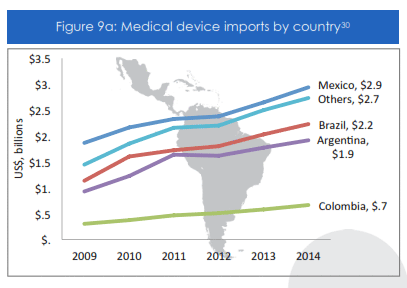In 2014, exports of medical devices to Latin America are expected to top $10 billion. Mexico, Brazil, Argentina and Colombia together accounted for more than 75% of imported devices. Mexico is the largest importer of the region with over $2.5 billion in 2014; spurred primarily by its proximity to the U.S., the North American Free Trade Agreement (NAFTA) and relatively low degree of local manufacturing. Brazil and Argentina are also large import countries, with ~$2 billion each.
Medical devices stand out because demand for innovative, high-tech solutions is largely driven by the private sector – in contrast to other types of healthcare expenditures, which are more evenly balanced between the private and public sector. with over 16,000 hospitals in the region, Latin America is an attractive market for many foreign manufacturers.
The weakening of currencies across the region will result in an overall drop in demand for imported, dollar-denominated devices and technologies; favoring locally manufactured equipment which may be less exposed to currency fluctuations. Foreign manufacturers and their local distributors will have to promote creative financing options in order to stay on top of the market and not lose share to less expensive products.
Imported devices trump local production
With the exception of Brazil, most countries in Latin America have little-to-no local manufacturing of medical devices or medical technology. Relatively small domestic markets have kept local players at bay, while weak intellectual property rights, questionable regulatory frameworks and a dearth of trained talent have held back foreign manufacturers from investing in the region. As a result, most countries rely almost exclusively on imports, especially for high-end, complex devices. A smart regional strategy will account for differences and clusters among local markets:
- Brazil is the region’s largest market for medical devices: the country accounts for 50% of the U.S. exports of medical devices to Latin America and has a strong domestic manufacturing industry of its own. It has evolved into a mature market for medical devices, complete with a more developed regulatory system than in neighboring countries. While Brazil represents a vast opportunity, importing into Brazil and local regulation are complex and costly to manage. Local competition should not be underestimated. A proper market assessment can help navigate some of these challenges, helping make the right decisions.
- Though Mexico’s market is second to Brazil in term of local demand for medical devices, it is in fact the region’s largest importer. Its proximity to the U.S., highly developed road systems, integration into the NAFTA, and robust export

- manufacturing (“maquila”) industry make Mexico a natural expansion when looking outside the US. Additionally, the state of Jalisco (Guadalajara region) has developed important capabilities in the healthcare space, primarily pharma and to a lesser degree devices.
- Beyond the top four markets – Brazil, Mexico, Argentina and Colombia – a second tier stands out, including Chile, Peru and Costa Rica. Each of these markets benefit from the right conditions to make theme attractive to medical device suppliers and manufacturers, including respect for the rule of law, favorable customs and import regulations and higher level of per capita spending on healthcare compared to regional standards, These can become lucrative, albeit niche export markets alongside the bigger regional players.



